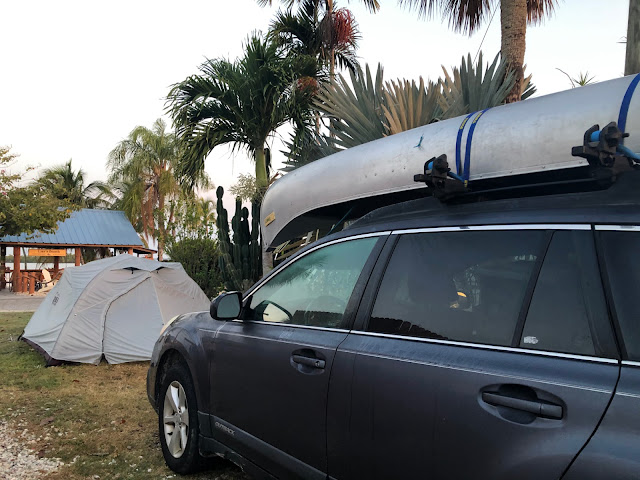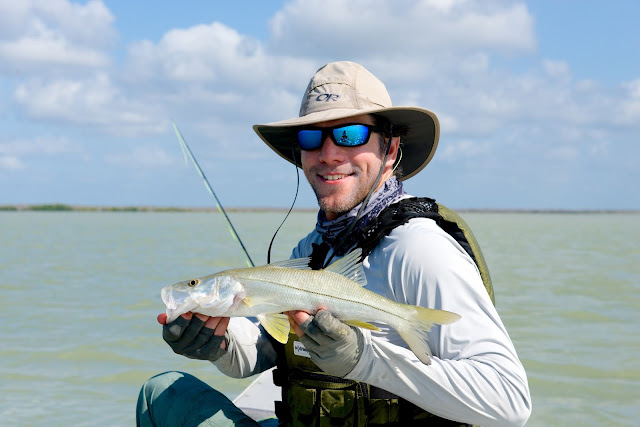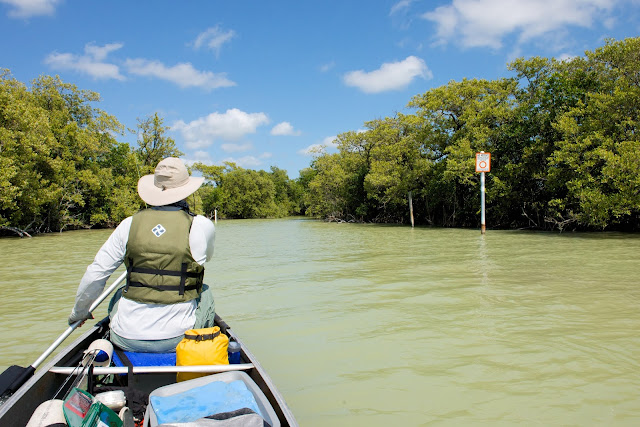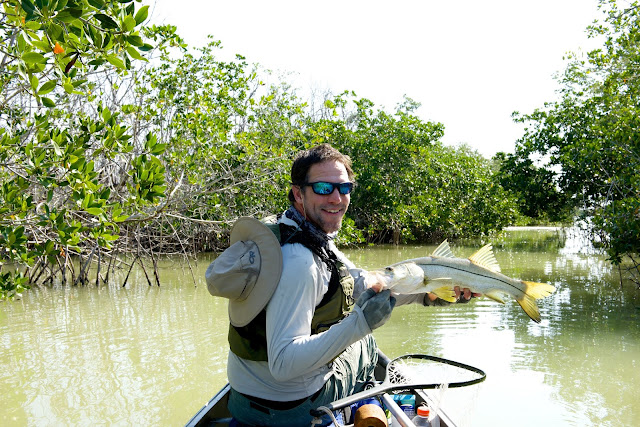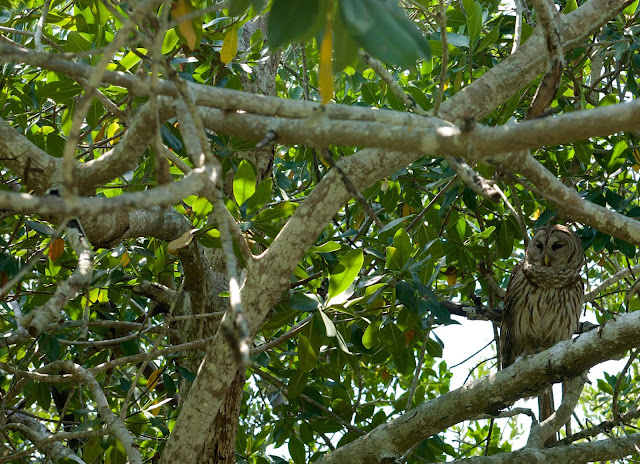DIY Flamingo!We got up early anticipating a long day of paddling ahead of us. We made breakfast and then took down the tent. By the time we packed the car back up it was near 8 so we decided to bead to the NPS visitor center to talk to the rangers and get any backcountry intel necessary before we went off the grid for a few days.
Our original plan was to paddle the full length of the West Lake Canoe Trail - leaving from a boat ramp on the park entrance road and winding our way through a series of lakes and connecting overgrown feeder creeks to eventually arrive at the Alligator Creek campsite. Much to our chagrin, the National Park Service decided to close down the West Lake launch site do do some boardwalk repairs - for a year! - after we made our plans and reservations. Driven by tales of abundant fish, we hatched a plan B to access the campsite by paddling 10+ miles across open water in Florida Bay to get to the campsite. It could be risky, said the NPS, but lots of guides in tricked out flats skiffs said it would be easy (for them) so we decided to go for it.
We were surprised to find that the park rangers were surprised, but delighted, we were headed back into Alligator Creek. If I remember correctly, Ranger Roxanne's comment was "Nobody goes back there [pause] have fun!" We didn't know if that was a good omen or a bad omen. They did tell us that the crocodiles did like to lay their eggs on the campsite beach, but, not to worry, they would be intimidated by our large selves, large canoe, and large tent. Somehow, that was not a compelling argument! Us old guys who pee in the night startle shit! A little daunted by the length of the first day's paddle, we changed our first night's camping location to the Shark Point chickee which would save us a few miles and give us the chance to fish on the way. We bought some park and kid merchandise and bid adieu.

At the Flamingo ramp, we unloaded the canoe, our equipment, food, and lots of water and parked the car. We took a few minutes to watch the manatees munching on barnacles along the bulkhead, or perhaps the algae in between, and then shoved off.
We were underway!
After about a mile, we passed Christian Point. On cue, just like a guide had told me, we saw a large tarpon roll. We paused, but it didn't surface again, so we just kept going. The shoreline on the horizon was far away.
We were paddling into the wind. Progress was steady, but the weight of our task was clear and present. The water was only a few feet deep. We got to a flat and there were fish busting all around us. Most were mullet, but we saw a few larger yellowish tails break the surface. We decided to drop anchor for a few minutes and fan casts. David still had his "creamsicle" fly on and within short order caught a nice little snook.
My turn, but I did not connect. Still nervous about not knowing exactly where we were going (couldn't see our destination) and having to paddle into the wind, we made a commitment to not fish and just keep going until we made it to the chickee.
Slowly, slowly, slowly we made progress. The shoreline on the horizon revealed herself teasingly. Because of the wind and chop, it was hard to see into the water, but we were spooking fish all along the way. About the only thing we could see in the distance was the fins of sharks. We kept going. We did see one large thing with a roundish shape. We're thinking that was a manatee. Somewhere along the way to Porpoise Point, we stopped for lunch. We were out there.
After lunch, we pressed on. Porpoise Point came into sharper view and we realize that we had finally crossed Snake Bight, but now needed to cross Garfield Bight. We could make out the chickee - its roof, its structure, and we were buoyed as we got closer and closer. We docked at the chickee after about 4.5 hours and 13 miles paddling into the wind. We spent some time looking around, sizing up the fish hiding among the pilings. I don't know about David, but I was a little disappointed; not surprised realistically, but the entire deck and all the railings were covered with bird poop. Kinda unappealing. Some fishing guides stopped by to let their clients use the porta-potty and were shocked to find that we had paddled there from Flamingo. We accepted their praise. It was still only mid-afternoon and the thought of being idle for so long before dark left us itchy, so we decided to ditch the chickee and press on to the Alligator Creek campsite.
We loaded everything back into the canoe and headed for Shark Point and then would follow the long bony finger of shoreline leading to Alligator Creek.
Inside Garfield Bight, the water calmed down and we could see more of the bottom. As we found small sheltered coves, David would take a few exploratory casts with the creamsicle fly.
In one, he spied a small school of fish and he hooked a small snapper.
With no sense of urgency, we paddled along the 3.5 mile shoreline, stopping here and there to take some casts. Eventually, we made it to the back of Garfield Bight, passed into the official no-motor zone, and found the entrance to Alligator Creek.
We dumped gear at campsite and decided to do some exploratory paddling up into the lakes - do a little recon for the next day's fishing. Alligator creek was narrow with lots of low hanging and overlapping branches. The water was a chalky green - nothing I had ever seen before.
As we made our way deeper into the creek, it was slow going as we picked our way through the tangle of branches, over sunken logs, bypassing the hanging red mangrove roots.
Spiders, having spun their webs among the branches, awaited their hapless prey and an evening meal. Not today fellas, not today.
We emerged into the first lake. In the image below, you can see how the creek connects to the first lake.
There were signposts, but no signs. We were later to find out that tourists steal all the signs for personal souvenirs - bastards!
We paddled around in the lake, saw lots of mullet, but were unsure if there were signs of larger predators. The water was about a foot deep and the tide was still rising. We monkeyed around for a bit, but not seeing much to cast at, we turned back so we didn't have to feel our way through the branches, spiders, and what ever else lurked in the brush after dark.
We made it back to camp, set up the tent, and explored around the campsite. The area that looked low and open on the aerial turned out to be thick knee-high shrubs so that discouraged a walkabout. There were a few paths, but they quickly petered out and didn't lead more than 30 meters or. so before they were overgrown with shrubs. It was beautiful though...
Under one of the trees, David found a full, decomposing bird carcass. No obvious signs of its demise - at least not to these amateurs.
We reconvened at camp and I started to boil water for dinner.
 The tide continued to rise, so much so, that we were worried about an overnight flooded tent. We picked it up and relocated it as far away from the shore as possible, only 2 or 3 meters really before we were up against the shrub edge. We crossed fingers and steeped our dehydrated sup. David did some plein-air painting...
The tide continued to rise, so much so, that we were worried about an overnight flooded tent. We picked it up and relocated it as far away from the shore as possible, only 2 or 3 meters really before we were up against the shrub edge. We crossed fingers and steeped our dehydrated sup. David did some plein-air painting...After dinner, the tide was still rising and there were fish breaking right in the creek off our campsite. Some of the fish seemed too large to be mullet. Thinking we were in baby tarpon country, I took many casts with larger 1/0 flies, but to no avail. Honestly, it was kinda depressing.
Neither of us wanted to talk about it, but the mosquitos were almost non-existent. As night came, we took to the tent. No sleeping bags, only sheets or silk liners, and the temp was right on the verge of uncomfortably warm. After about 14 miles of paddling I figure, we fell asleep to the sounds of bait-busting fish and owls hooting the make themselves known.
Flamingo DIY - Day 2
We woke with the sun, keeping a lookout for egg-laying crocs as I hustled off for the morning pee.
I have to say, I was in a little funk. Our exploration the day before did not seem promising, and I wondered what I had gotten David into. For good luck, I changed into fresh clothes before boiling water for breakfast. Turns out, I mis-packed and we were running short on coffee - another bad one? I sacrificed so the doctor could get his fix. I set up the campsite fly tying station and cranked out a few more creamsicle flies. But due to the chalky water, I used an EP minnow head brush with a little flash in it - the backcountry sparkler was born!
After downing our oatmeal, we filled several water bottles each and packed up the canoe for a day of fishing. At least for me, we half-heartedly picked our way up the creek on the rising tide.
We took our time on the rising tide, making our way through the Alligator Creek maze and into the first of the series of lakes like the day before. The chalky mud bottom was only a foot deep and that made the water color range from a chalky yellowish-green to turquoise color.
Along the shoreline of the lake, many of the trees were dead - a consequence of the latest hurricane. Lots of fresh growth seemed to be reclaiming the ghost forest.
As we paddled across the first lake, like the night before, it seemed like there was nothing there except jumping mullet. On the far end of the first lake we did spot what we thought was a small crocodile.
We paddled into the next narrow channel leading to the paired lakes called The Lungs. The creek was a wee bit wider but we still had to pick our way through the overhanging tree limbs and the twists and turns of the narrow creek before making our way into The Lungs. When we approached the opening into the lake we saw some large tails which we thought were snook. Being in the front of the canoe, David was first up, and within a few casts, hooked his first fish on the same creamsicle fly he had been using since Chokoloskee. The fish ran straight for the mangrove roots and then under the boat. We thought he would break his rod as it doubled over under the canoe. He handed me his rod we worked around the end of the canoe I gave him his rod back and we landed the fish. It was glorious - a nice snook pulled out of Alligator Creek. Out spirits soared!
After the release, David spun the canoe around so I didn't have to cast past his ear.
And in short order I landed another mud-lake snook - this time, on the backcountry sparkler. That color combo is money!
We were in the groove now. We took turns casting and hooking snook and ladyfish, working back and forth in the creek pockets all within 100 meters to the lake entrance. The water was deep here - over 3 meters so it made sense the fish felt safe here as opposed to the foot-deep lakes.
During one of my turns, the line came tight right at the lake entrance and a tarpon rocketed several meters into the sky where it immediately spit the hook! 2/3 of the hook-jump-land trifecta! We fished that area for a while, but got no repeat performances. Having put the fish down in the entrance creek we entered The Lungs proper. We didn't see a whole lot of activity in the lake itself so we worked our way to the outlet creek - hoping to find some magic there. On the way, we saw some mullet activity so David took some casts and came tight on another snook.
We made it to the lake outlet and saw a little activity, but nothing like the entrance creek so we paddled back to find the busting fish had returned. This was our honey-hole...
... and we continued to catch fish here.
During one of my turns, I back cast into an overhanging tree. While trying to free the hook, I lost my balance and threw the rod towards the canoe as I went over the side.

David was calling me frantically to get back into the canoe, but I was focused on freeing my tangled line, and retrieving a portion of the rod that had separated. David was worried I had hit my head during the fall, but I told him I was OK. I was so intent on making sure my rod and line were OK, but in retrospect I realized perhaps he was worried about the gators and crocs. He never said anything about that, but later confessed he was. Oh well, the gods were looking out for me and all I got was damaged pride. After freeing the line and restringing the rod, we continued to catch fish until the tide went slack at approximately 3:30 in the afternoon. We stowed everything in the canoe and we headed back to camp to pack up and make our way to the Shark Point Chickee where we would spend the night before the final push back to Flamingo the next day.
On the way back, David spotted a barred owl down in the mangroves near the water. As we approached he moved higher into the trees, but didn't take flight. He didn't seem too frightened by us.
It was so cool to see such a magnificent animal up close!
David called to it and it called back and that went on for a few minutes - call and response, call and response, and even as we paddled away the owl kept calling his new friend David.
Continuing back to the campsite, I had to stop and get some photos of the red mangrove roots; I was just fascinated by their arching and beautiful structure.
We made it back to the campsite packed up the tent and the rest of the equipment and aimed the canoe south towards the Shark Point Chickee. We retraced our paddle strokes the 3.5 miles to get there around 5 pm.
Upon arriving at the chickee David was intent on catching a really big fish that was cruising around the structure and watching the schools of mullet that would dart about or hide in the shadows of the decking. I got busy heating up water for our "just-add-boiling water" dinner. I used the no-snag canoe tarp cover to keep off the guano.

As we waited for the dinner to steep, David posed the question whether I really wanted to sleep on the chickee, if I needed to check that box on our Everglades adventure. I was pretty ambivalent because the deck was covered with bird poop and exposed nails posed a hazard to the delicate skin of tent floor. The next day's weather also called for strong headwinds with gusts up to 25 miles per hour. We thought hard about making a break for the Flamingo campsite and, instead of just killing time on the chickee, we ultimately decided to gobble down our dinner and charge for the barn. We packed up quickly, got in the canoe, and David set a blistering pace - racing against the setting sun.
We made excellent time past Porpoise Point. There was no stopping this time, and very little talking. The water was crystal clear, the winds were light, and we made our way quickly, looking at the bottom and the seagrass and algae and horseshoe crabs and other critters as we went. The setting sun beckoned us to paddle faster, but we reveled in that magic light.
As we got closer to Christian Point, David pointed out these splashes occurring all along the island and mainland shorelines. I guess they were dolphins? Wrong! David deduced correctly that they were mullet jumping. We watched them as each paddle stroke pulled us closer to Flamingo. We kept looking for benchmarks to measure our progress. Where were this channel markers we had seen just the day before (in full light). We watched the sun accelerate as it ducked its head being the shoreline.
We were close, but we were hoping to at least make it to Christian Point before we lost all light. We could then follow the shoreline straight to the Flamingo boat ramp. We were in after-glow, but relieved, when we reached Christian Point.
After crossing the Christian Point line, like clockwork, two large tarpon surfaced. David encouraged me to take some casts in the waning light. I argued that if I hooked one, we would be towed around in the dark, but he appealed to my sense of adventure so I pulled out the big gun, my 11wt Sage, pre-rigged with a tarpon toad, and waited for a target. After about 10 minutes of slowly paddling in the vicinity of the rise and not seeing them again, we made the final push for Flamingo.
We easily found the entrance to the Flamingo marina and pulled up to the ramp. It took us 2 hours and 45 minutes to do the 13 miles from the Shark Point Chickee - traveling twice as fast as the day before. For a total that day, we calculated that we had paddled approximately 20 miles. Wind and dread makes a difference!
This was our path. Red stars are where we caught fish.
Tired and sore we gathered all the equipment from the canoe, hastily threw everything in the back of the Canoe-bar and secured the "silver king" to the Thule roof racks. We made our way to the camp entrance kiosk and asked to be allowed to camp at Flamingo in exchange for the reservation we had paid for at the chickee. Also we had a reservation for there tomorrow anyway. The Flamingo Adventures employee was cool about it and told us to take any site except the two being reserved for campers that hadn't arrived yet. We happily complied.
We set up the tent and then both took long, hot showers - me peeling off my salty swim clothes. We rinsed off the rods, brushed teeth, and settled in for the night.
Glades Walkabout
The next day we were in no rush to get up we made breakfast. We scrounged around to find whatever cleanish clothes we could find as we were reentering humanity. We decided to head north to explore some trails at the Fakahatchee Strand Preserve and Big Cypress Preserve. We stopped in Homestead and got breakfast at a Starbucks and leisurely ate outside. When we got to the Tamiami Trail, we pointed the Canoe-baru west stopping to take in the gator sightings - they are hard to pass up.
We stopped at the Big Cypress Oasis Visitor Center, got out our National Park passports for a new stamp and, walked their short boardwalk before departing.
Our first hike was short, along the Facahatchee Strand Preserve boardwalk trail to look for dwarf white orchids, but unfortunately we didn’t see any in bloom.
We did see lots of cool plants and David taught me how to use the iSeek app to identify plants. The trail culminated at a pond where multiple gators were in residence.
The boardwalk path wove in and out of wetlands so of course there were snakes - this one a venomous cottonmouth. Glad we were safely elevated about him.
After the short walk, we lingered at a picnic table shaded by a large palm tree and had lunch. In the canal nearby, we found this little guy.
Driving further west, and then north, we went to check out the Fakahatchee Strand State Preserve, but found the visitor center and observation tower closed. It looked like there were miles and miles of dirt road that made for good biking. In fact there were lots of cyclists massing there, but without any information on short hikes, we bailed.
On the way back east, we stopped at Joanie's for a cold beer. We had intended to stop by while we were in Chokoloskee, but they close kinda early and we were always getting in too late.
I love these signs that ignore the native Americans that existed in the area long before it was "founded" or "discovered" by white men. Hell, the Miccosukee tribal lands are just down the road. Oh, well... David also told me about an app that is GIS-based and no matter where you are, it will tell you what native Americans lived there before European occupation. I need to find that app.
Joanie's is definitely and interesting place and it draws a clientele to match. We struck up a conversation with two 20-something artists from Miami who started us off by saying "Hey you guys look cool, what are you up to?" Clearly, they had not honed their character assessment skills.

While we sipped our beer and eavesdropped on the artists' youthful and rapid fire banter, we munched on gator bites and fried green tomatoes - when in Rome....
The beer was refreshing, but now we were stuffed. Time to walk it off/. We headed back east on the Tamiami Trail and made a right-hand turn onto route 94, aka the Loop Road, for some sightseeing along an undeveloped dirt road. Every so often we would cross a small bridge and these crossing always enticed us to stop and observe all the tropical fish, plants, birds, and gators there in abundance.
Along the Loop Road is a small trail that leads you through a portion of forest where rare tree snails could be found. Since we didn't know what to look for, it took us a while to spot one, but after David spied the first one, it was like a scavenger hunt to find more in the tree joints, bends, and hollows.
We continued to mosey along the road, stopping at the bridges.
At one spot there were all these vultures with their wings spread and prancing around - some sort of mating ritual we wondered?
While the action was hot and heavy on the ground, even the vultures in the trees were getting into the act.
It was cool seeing all the plant epiphytes and bromeliads too. We stopped again so David could use his newly acquired "snakes of the Everglades" guide to ID one of the guys crossing the road.
I yelled to David that venomous snakes could jump 2 1/2 times their body length to strike, but he paid me no mind. Perhaps a mangrove salt marsh snake?
Rejoining the Tamiami Trail, we pointed the Canoe-baru east again and toyed with the idea of finding a cheap hotel in Miami to avoid the super early wake up call and 2-hour drive to get David from Flamingo back to the airport. After a couple of disappointing calls and online searches, we couldn't find anything on a Saturday under $200, so we abandoned that idea and made our way back to Homestead for a gas stop and got more coffee before the dark drive south to Flamingo. On that long, undeveloped entrance road, David got out his flashlight and started searching for more snakes are dead or alive.
Is this an Everglades Rat Snake? He's a long fella!
The following is what you call your common "unlucky snake" aka "Roadkillis flattenous"
Some critters must've benefited from the carnage. Even the venomous cottonmouths that got hit you kinda felt sorry for...
So many must die this way; what a shame! As the curtain of darkness rapidly fell, we stopped to escort this turtle across the road so he wouldn't become soup.
It was pitch black, again, when we arrived back at Flamingo. We put up the tent, indulgently showered again, brushed our teeth, and went to bed preparing mentally for the early morning departure to take David to the Miami airport.
Homeward Bound
We got up at five. I took a quick shower to wake up and brushed my teeth. I hustled back to the tent for a hasty break down, we threw it into the car, and then we raced north towards the airport. David again had his sharp eye looking out for snakes but we didn’t see any on the cool morning pavement. We stopped to get a quick extra large coffee in Homestead at the Starbucks and then continued on to the Miami International Airport.
We arrived at 7:30, perfect timing, and said our goodbyes. I wheeled the Canoe-baru away from the curb, navigated my way out of Miami and found Interstate 95 and headed north towards Saint Augustine and lunch with Jimmy and Joanne. After about 4 1/2 hours I made it to
their condo and they had a nice sandwich, chips and an ice tea waiting for me.
We talked about life and Florida politics for a couple hours while looking out over the beautiful marsh behind their condominium. I finally had to pull myself away to get moving and get as far north as possible. I called Kathi to let her know I was making progress north and kept going! As I found my way back to I 95, I was overcome with the desire to get home so I resolved to make it to Virginia Beach, inspired by our marathon paddle just a couple days before. I stopped just over the Georgia border to re-caffinate and then continue north. I think I stopped in NC to grab some dinner, but keep forging North. I was relieved when I made it to Emporia as I was getting tired and was hoping for a boost of enthusiasm (if not energy). That road east is lonely and dark. I did see a few deer to keep me on edge. After about 1,100 miles, I finally rolled into the driveway at around 2 am and glad to be home.
What were the takeaways from the trip?
- Always bring a travel vise and tying materials
- A canoe seat with backrest is essential for comfort and doubles as a camp chair in the backcountry
- Hire a guide in every new situation you fish.
- Carry a full plastic tarp into the backcountry to sit on or whatever
- Going to places that nobody goes is what adventure is all about!
Peace


 The tide continued to rise, so much so, that we were worried about an overnight flooded tent. We picked it up and relocated it as far away from the shore as possible, only 2 or 3 meters really before we were up against the shrub edge. We crossed fingers and steeped our dehydrated sup. David did some plein-air painting...
The tide continued to rise, so much so, that we were worried about an overnight flooded tent. We picked it up and relocated it as far away from the shore as possible, only 2 or 3 meters really before we were up against the shrub edge. We crossed fingers and steeped our dehydrated sup. David did some plein-air painting...





















